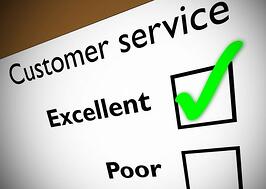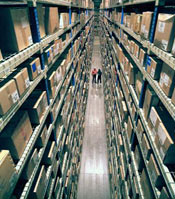By Chris ParryAtlantic Publishing
Getting the Most From Your Patrons
The patron walks in with $20. When the well is dry, he or she will go home (or possibly procure more) but how do you make sure you get as much of that $20 as possible? Consider the following:
- Value-add! It might cost you a buck to make a bourbon and coke and it might cost you two bucks to make a burger. Why not offer your drinkers a cut-price deal on that burger during a certain time of the night: buy two drinks, get a free burger to go with it. You're not making any money on that burger, but you are ensuring that the customer will stay in your bar while they eat it - and probably a little longer. Heck, they might even order a side of deep-fried mushrooms to go along with it.
- Make it easier to stay than go. If your staff is asking people, "Should I get you the bill?" instead of, "How about a round of coffees?" you're only giving your customers an excuse to hit the road.
- Keep the TV interesting. A big error many establishments make is that they leave a TV on but don't pay any attention to what's on it. Keep an eye on your screens and keep an even bigger eye on the TV Guide, to make sure that, if at all possible, you're giving your patrons a reason to stay: "Ooh, ER is on! Maybe I'll have another...
- Read the crowd. On any given night, your entire customer base can change radically. If you look around and find that there are a lot of young people in the place, adapt to suit that audience. Run a one-off special on tequila shots or shooters or turn on the dance-floor lights. Likewise, if a sports crowd comes in unexpectedly, get them into the swing of things by adapting to suit their needs.
- Give valued employees the power to make executive decisions. There's nothing worse, as a customer, than being told, "I don't know, the manager isn't here until later tonight..." Make sure you always have people on staff who can handle a situation and even veer away from the way things normally run, if common sense dictates it. Trust your people to make the right move.
- Cut down on your "no" answers. You might stock Diet Coke, but what about Diet 7-Up? What about veggie burgers? What about fresh-squeezed orange juice? There might not be a whole lot of demand for these products, but if you don't have them when they're asked for, you're giving your customers an excuse not to return, even if they don't make a big deal about it at the time. Don't sink money into something that won't sell, but don't go the other way and reduce what you can sell.
- Merchandise sells! A funky logo doesn't just make your venue more appealing; it sells, too. Research shows that the McDonald's logo is more recognizable to children than the cross symbol of Christianity; so it stands to reason that you could profit nicely from a logo that is "cool" enough for people to wear. T-shirts, golf shirts, baseball caps, key chains, lighters and souvenir glasses - take a tip from the Hard Rock Cafe: if sold well, merchandise can be a bigger earner than alcohol.
This article is an excerpt from the Food Service Professional Guide to Bar & Beverage Operation, authored by Chris Parry, published by Atlantic Publishing Company. This excerpt has been reprinted with permission of the publisher. To purchase this book go to:
Atlantic Publishing Company
Amazon.com
Topics:
Bar staff,
NightClub Management,
bar business,
profit,
Bar Management,
Increasing Profits
By Chris ParryAtlantic Publishing
Part 2 of 2: Protecting Your Profits
Your profit margin, like that of any business, is fragile at best. You can sit down with a calculator and try to calculate the exact percentage you'd like to see on each drink. But in practice, a little splash too much here and there can see you falling perilously close to a loss. Follow these rules and you'll be that much more likely to see your bottom line behind the bar match that of your balance sheet estimations.
- Watch what your staff pours. Regularly measure what they consider an ounce. If just one bartender overpours 40 shots a night by 25 percent, you've given away ten drinks for nothing. This kind of waste can get very expensive, especially if you have a large bar staff and they're all pouring more than 40 drinks per night.
- Have your staff keep all the liquor in the glass. Many staff members get lazy as the night wears on, and inevitably they'll start taking shortcuts. One shortcut many take is to line up three or four glasses and pour one after the other in a straight line without raising the head of the bottle. While this may save them a second or two, it also pours a lot of your product directly onto the bar surface, not to mention down the sides of the glasses that your customers are about to put in their hands. It also means your customers are far less likely to get what they've paid for. Don't let it happen.
- There are alternatives to free-pouring. While free-pouring certainly is more stylish and perhaps faster than measured pouring, it is also definitely far from accurate. As bar staff generally tend to err on the side of caution, they usually pour too much rather than too little. Control-pour spouts, such as Posi-Pour spouts, are a little more expensive than the usual free-pour, but they give a far more accurate pour without the need for clunky overhead systems or sophisticated electronics - and at much the same speed as free-pourers.
- Liquor control system. If you really want to keep an eye on your outgoings, a liquor inventory control system may be your answer. The price of setting these systems up, and maintaining them, can be significant. Then again, you get what you pay for.
This article is an excerpt from the Food Service Professional Guide to Bar & Beverage Operation, authored by Chris Parry, published by Atlantic Publishing Company. This excerpt has been reprinted with permission of the publisher. To purchase this book go to:
Atlantic Publishing Company
Amazon.com
Topics:
Bar inventory,
managing liquor inventory cost,
bar business,
profit,
Bar Management,
alcohol cost,
bar control,
controling costs
 By Douglas R. BrownAtlantic Publishing
By Douglas R. BrownAtlantic Publishing
Part 6: Purchasing and Ordering--Procedures and Practices
Purchasing and Inventory Software
Purchasing and inventory software is readily available to restaurant operators. Many larger organizations are using inventory control software that saves a significant amount of time and money. Most managers are used to the monthly grind, standing in the walk-ins counting eggs, butter pats and frozen chickens. With inventory control software, managers can use a laser scanner, similar to the ones used in grocery stores, to scan bar codes. The software can also be linked to your distributors and you can place your orders electronically based on the inventory.
- Consider placing your orders online. Almost all distributors now have systems in place to order online. The advantages are numerous: it reduces ordering errors, it's convenient, there may be discounts, and most systems build a customer database based on what you have previously ordered making re-orders easy. A list of vendor Web sites follows:
www.usfoodservice.com
www.sysco.com
www.seafax.com/cgi-bin/WebObjects/Seafax
www.tampamaid.com
www.foodservicecentral.com
www.foodservice.com
www.fbix.com
www.buyproduce.com
www.agribuys.com
www.alliantfs.com
www.gfs.com
www.nugget.com
www.pyamonarch.com
www.pocahontasfoods.com
www.whitetoque.com
www.syscono.com
- Use written purchase orders (PO). A PO is a written authorization for a vendor to supply goods or services at a specified price over a specified time period. Acceptance of the PO constitutes a purchase contract and is legally binding on all parties. Utilizing POs will enable you to know what was ordered, the quantity, and the price. If you are using software to record the invoice and receipt of inventory, the program will restock and adjust pricing automatically. In addition, your perpetual inventory will be updated. Purchase orders from software programs can easily be faxed or e-mailed into the vendor, saving time and money.
- When purchasing food, avoid more expensive name brands wherever possible. Of course, you want to make sure you're buying quality ingredients for your food, but are your customers really likely to tell the difference between a "name brand" and an "industrial brand"?
- Local growers. Talk to local fresh-produce suppliers to see if you can't get fresher, cheaper, better-quality fresh produce direct from the grower. Why pay a supplier to get the fruit and vegetables that are shipped to their central warehouse, then shipped back to you, when you can just drive 10 minutes down the road and enjoy food right off the tree or vine? You can also use this as a promotional device. If you use local produce, let your customers know!
- Cooperative purchasing. Many restaurants have formed cooperative purchasing groups to increase their purchasing power. The cooperatives purchase items that are commonly used by all food service operators. By joining together to place large orders, restaurants can usually get substantial price reductions. Some organizations even purchase their own trucks and warehouses and hire personnel to pick up deliveries. This can be advantageous for restaurants that are in the proximity of a major supplier or shipping center. Many items, such as produce, dairy products, seafood and meat, may be purchased this way. Chain restaurants have a centralized purchasing department and, often, large self-distribution centers.
- Make sure you shop for purveyors. Don't rest once you've found one. Comparison shop on a continual basis.
- Look at vendors' product labels for box strength. This will tell you where the product came from. Most manufacturers won't ship more than 100 miles away from their plants. The further away that a supplier is located, the more shipping will cost.
- Consider planting your own herb and/or vegetable garden. Great food starts with using the freshest herbs and vegetables and the best way to do that is to grow them yourself! The techniques for growing your own are not difficult. With a little planning, you can build your own 24-hour supply of garden-fresh herbs. Even a small garden can infuse your kitchen with heavenly aromas and striking flavor. What a great way to lower your food cost and separate yourself from the competition! You can buy seeds online at:
www.burpee.com/main.asp
www.dansgardenshop.com
www.johnnyseeds.com/catalog/index.html
www.richters.com
www.parkseed.com
Topics:
Food Costs,
profit,
food inventory,
purchasing
By Elizabeth GodsmarkAtlantic Publishing
Part 6 of 6: Valuation and Control of Inventory
Inventory Valuation Made Easy
Daunted by the pros and cons of the various accounting procedures used in today's liquor, wine and beverage industry? No need. Choose the approach that best meets the requirements of your establishment. Keep it simple. The following methods are tried and tested. They are also known for their ability to control cash flow and to reduce overall costs.
- FIFO (first in, first out). This means that items in storage are valued at the level of the most-recently purchased items. FIFO helps maximize profits by extending inventory value, particularly when inflation is high. A word of warning, though: Make sure that all profits are accurately recorded and that all drinks are rotated on a strictly first-in, first-out basis.
- LIFO (last in, first out). Here, the most-recent items are recorded as the first ones used. This method is useful when prices are rising, fast. Rotate stock on a FIFO basis, but make sure that the value of the inventory reflects the oldest purchase prices. If your product valuation is keenly affected by inflation, use LIFO!
- Actual Method. With the Actual Method, the inventory is valued at actual cost. It's a bit time consuming, unless you have a computerized system - even then, the Actual Method is probably not the best choice for reducing costs.
- Last Price Method. Similar to FIFO, this is one of the most commonly used accounting procedures used in the beverage industry today. It involves using the last purchase price to extend inventory value.
- Computerized packages. Whatever your choice of method, a good-off-the-shelf package for calculating inventory values is a must.
Controlling Bar Inventory
Wastage, spillage, employee theft, oversights and inefficiency are most likely to occur in the working environment of a busy bar. Improved management of bar inventory can make a big impact on profits. Even one bottle of liquor represents a substantial profit - or loss. Introduce a few changes behind the bar. Small adjustments can make a big difference!
- Security-mark bottles. Security-mark every bottle of liquor destined for the bar when it is received into the storeroom. This identifying mark, stamp or nonremovable label (placed on the bottom or side of the bottle) proves that the bottle belongs to your operation. If you are using a computer-controlled inventory system, consider using a bar-coded label for better inventory control.
- Unauthorized sales. Empty bottles returned without a mark indicate that bar staff may possibly be serving liquor from unauthorized bottles. It is not unknown for employees to bring in their own bottles in the hope of making a fast buck!
- Control cards. All inventory requisitioned by the bar must be recorded in the perpetual inventory, usually by computer. A backup card system can act as an invaluable "double check." Don't make it complicated. All you need is a date and signature against the item.
- Bin cards. Bin cards give you extra control over high-value items. Fix small index cards (known in the trade as bin cards) to the shelves where such items are located. Keep a careful eye on the running totals.
- Backup liquor. Even on a typical busy night, one bottle of premium liquor and two to six bottles of well liquor is sufficient backup.
- Accurate records. Distinguish clearly between unopened and opened bottles when valuing inventory. Opened bottles should be measured to the nearest tenth of a bottle, using dipsticks or by weight.
Topics:
liquor inventory,
profit,
controling costs
By Elizabeth GodsmarkAtlantic Publishing
Part 6 of 7: Purchasing Specifications and Set Standards
 As a purchasing manager, it is important to set standards. Decide up front exactly what types of drinks you need to purchase and the conditions under which you will place an order. These are your purchase specifications.
As a purchasing manager, it is important to set standards. Decide up front exactly what types of drinks you need to purchase and the conditions under which you will place an order. These are your purchase specifications.
- Consult fellow members of staff. Their input is important. Of course you want them on your side, but oftentimes, it is they who know best what will sell (and what won't!).
- Purchase specifications must reflect the image of your establishment. Consider your target audience, the standards it demands and the price it is prepared to pay.
- Keep a written copy. It represents your establishment's overall purchasing standards and rules. It doesn't have to be a lengthy document; a few bulleted points will do.
- Purchase specifications should focus on the following areas: quality, quantity, consistency, reliability of vendors and availability of merchandise.
- Document your purchase specifications to vendors. Vendors need to be reminded of the standards you expect from them. Specs are also useful in the event of a dispute.
- Back up your purchase specification document with an additional product information list. Tabulate the information in chart format. Include information such as brand, country of origin, alcohol content (where applicable) and, in the case of wines, year and vintage. Use it to jog your memory when writing out purchase orders or placing orders by phone. This type of handy list can also help you spot "substitutes" when you receive the goods!
Topics:
profit,
controling costs,
purchasing,
inventory control
By Elizabeth GodsmarkAtlantic Publishing
Part 5 of 7: Streamline Your Receiving Procedures
 This area of purchasing offers a great scope for cost reductions. Unfortunately, it is often neglected. Do so at your peril! Many well-devised purchasing plans fall at this last hurdle. Don't marginalize this important procedure.
This area of purchasing offers a great scope for cost reductions. Unfortunately, it is often neglected. Do so at your peril! Many well-devised purchasing plans fall at this last hurdle. Don't marginalize this important procedure.
- Check merchandise thoroughly. Even when you are in a hurry, it is vital to check all received merchandise carefully. It may be your only (and last) chance to identify problems. Most vendors have a time limit written into their contracts for notifying them of discrepancies and shortages.
- Adopt a "checklist" approach. The person receiving the merchandise needs to do the following:
-Verify the supplier
-Check quality
-Check quantity
-Check price (if applicable)
-Note any discrepancies on the receiving note
-Sign and date, only when satisfied with the above
- Follow up any queries. Contact the vendor (preferably in writing), outlining any shortages, discrepancies or other problems, immediately. Most problems are quickly resolved. But stating your dissatisfaction, in writing, is a wise move. Sometimes queries become wrangles and you can end up with a long, drawn-out dispute on your hands. It's good to have something in writing!
- Tie up paperwork. Tedious, but important! The person who receives the goods or a designated member of staff needs to mark all invoices with some form of "Received" stamp, noting the date of receipt and who received the merchandise.
- Introduce a random audit of your receiving process. Identify any problem areas before they get out of hand! A basic audit should compare quantity and quality of merchandise delivered with the original purchase order. Carry out a volume or unit count of liquor, wines and beverages. Also, double-check that cases contain the number of bottles stated on the "outer." Finally, check that all documentation has been accurately processed.
Topics:
profit,
purchasing,
inventory control



 By Douglas R. Brown
By Douglas R. Brown
 As a purchasing manager, it is important to set standards. Decide up front exactly what types of drinks you need to purchase and the conditions under which you will place an order. These are your purchase specifications.
As a purchasing manager, it is important to set standards. Decide up front exactly what types of drinks you need to purchase and the conditions under which you will place an order. These are your purchase specifications. This area of purchasing offers a great scope for cost reductions. Unfortunately, it is often neglected. Do so at your peril! Many well-devised purchasing plans fall at this last hurdle. Don't marginalize this important procedure.
This area of purchasing offers a great scope for cost reductions. Unfortunately, it is often neglected. Do so at your peril! Many well-devised purchasing plans fall at this last hurdle. Don't marginalize this important procedure.
